Selection criteria and painting rules: paint for heating radiators
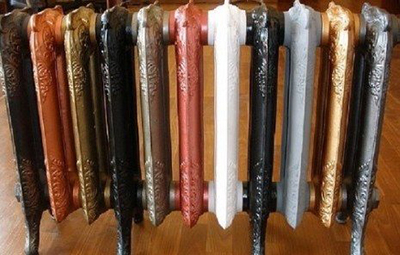
The main criterion that is used when choosing paint to protect radiators is its ability to maintain its properties under the influence of high temperatures.
The surfaces of water radiators become hot up to 70–75 degrees, and the steam heating elements are up to 100 and above.
Properties of paint for heating radiators
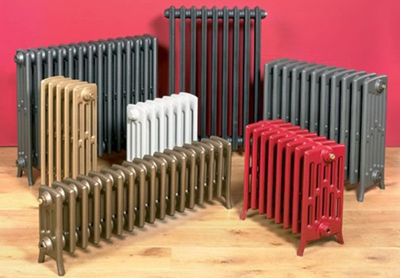
Paints and varnishes (PVM) that do not have heat-resistant properties, may peel off, change color, crumble.
It is recommended to purchase paint that:
- endures steadfastly heating up to 80–100 degrees;
- not afraid of moisture and mechanical impacts;
- is non-toxic;
- has good thermal conductivity;
- has high speed of interlayer drying.
Dependence on the type of surfaces to be painted
For coloring cast iron For products, it is enough to choose universal types of enamel, even oil, if temporary treatment is needed.
Other types of radiators and pipes are coated with alkyd enamels or acrylic compounds, after having previously prepared the old layers of paint already applied at the factory. This concerns aluminum, steel and bimetallic products.
Choosing a Heat Resistant Paint
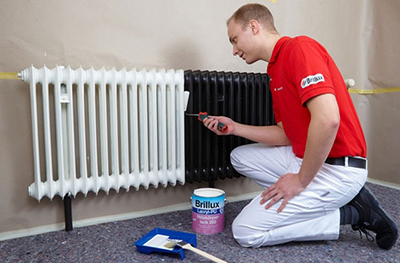
When purchasing paint and varnish materials, it is important to carefully study the label, which contains the following information:
- for what surfaces the product is intended;
- is it possible to use in residential premises;
- drying time each layer;
- at what temperatures can the coating be used;
- best before date.
Reference! It is not recommended to buy paint, if the label is missing or illegible, there is no clear indication of the manufacturer or the date of manufacture.
There is one on sale two types paints by type of coating obtained: matte and glossy.
Glossy ones are fine for flat surfaces, When used correctly, they will give a shiny and pleasing to the eye surface.
Matte - preferably to use for coating cast iron radiators, from which it is difficult to completely remove old layers. It will help to hide unevenness and defects.
If you want to get an original texture that will emphasize the style of the room, then it is appropriate to resort to powder coating.
Alkyd
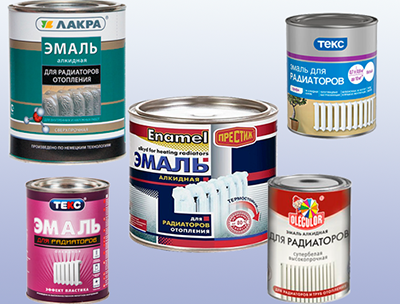
The enamel forms a durable, shiny coating. If the manufacturer's recommendations are followed, the surface painted in two layers will last 4–5 years.
According to the composition of the base, alkyd paints are classified as three types.
- Manufactured using organic solvents. They have a specific smell. The can should have a mark indicating the possibility of use at a temperature not less than +70 degrees.
- The acrylic water-based alkyd composition has virtually no odor. However, a number of products cannot be used for radiators and metal in general. You should study the manufacturer's recommendations. Chalk should not be among the paint ingredients. Expensive titanium white is used as a pigment, which increases the cost of the product by about two times, but does not allow the paint to fade over time.
- Paints and varnishes containing organosilicon base, are used for painting surfaces that heat up to temperatures up to 600 degrees. During the process of hardening of layers, toxic substances are released, therefore it is necessary to ensure good ventilation of the room during work, it is advisable to use a respirator.
Alkyd compounds are sold in the form of metal containers - buckets (up to 25 kg) and cans (0.5–3 kg).
The layers take quite a long time to dry, so the painting process is delayed. for 2-3 days.
Acrylic
Acrylic compounds form smooth, plastic-like coatings — as a result, surfaces are formed: semi-glossy or matte. The smell is almost absent.
They are diluted with ordinary water and require careful preparation for painting (using primers). Drying time before applying the next layer is 2, and complete drying - 24 hours.
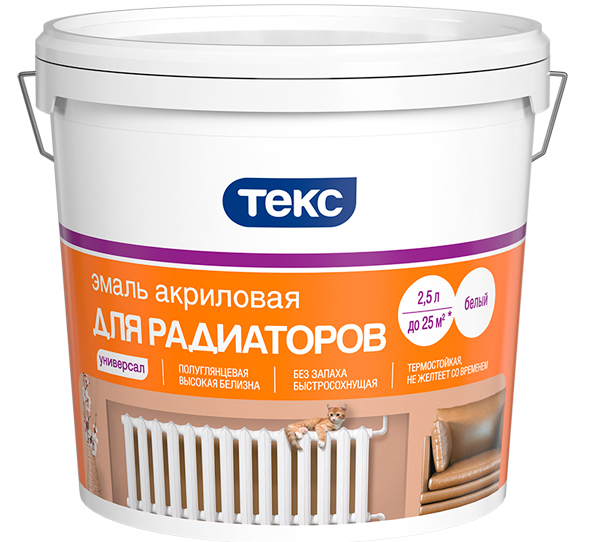
Photo 1. Acrylic semi-gloss enamel without odor for radiators from the manufacturer Tex.
One of the downsides is not too high durability to mechanical influences.
Acrylic compounds are also sold in the form of primer-enamels; in this case, it is not necessary to prime the surfaces separately.
Packaging is done in plastic jars and buckets of various sizes - 0.5 kg and more capacious.
Oily

They are produced on the basis of organic drying oils.
Previously often used for coating heating devices and pipes, but they have too many disadvantages, and therefore, even taking into account the low cost, they are rarely used.
Characteristic smell does not weather for a long time. Over time, the coating loses color and cracks, after which it flies off in pieces. Difficult to clean for subsequent painting.
During work, defects (massive streaks) may form due to high fluidity and long drying time. Thick layer disrupts the heat transfer of batteries.
Sold in metal cans of various capacities.
Silicone for metal
They are created using silicone resins and organic or aqueous solvents. Withstands almost any temperature, which water radiators are subjected to. After drying, the coatings acquire a semi-matte shine.
They do not require special preparation of the surfaces to be painted and are highly resistant to mechanical impacts. The average time for complete drying is 2 hours.
High price does not make silicone compounds popular for painting household heating appliances.
There are metal and plastic containers on the market. from 7 to 25 kg.
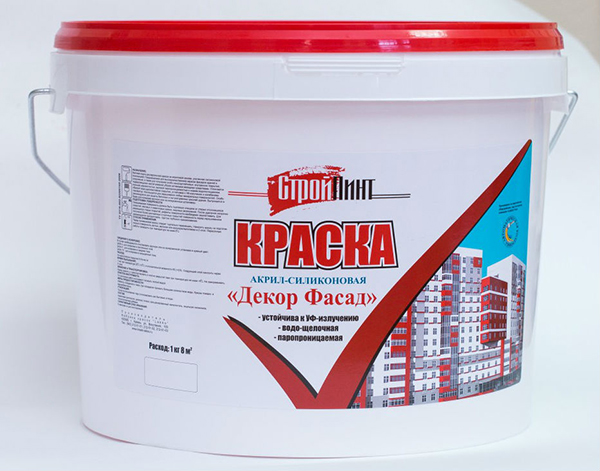
Photo 2. Acrylic-silicone water-alkaline paint for heating radiators from the manufacturer StroyPint.
Powder
Powder coatings are considered the most durable. However, complex coating technology limits their use in everyday life.
The essence of the method is to create a coating inside a special paint chamber at a certain temperature and humidity, as well as preheating the part.
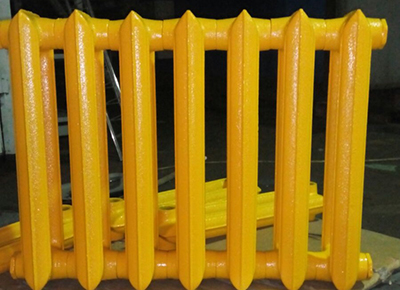
Difficulty of independent implementation The advantage of this method is that a positive charge is applied to the surfaces being painted, and a negative charge is given to the sprayed powder.
As a result of chemical processes, polymerization of the composition.
The method is remarkable in that with maximum savings the result is smooth and durable monolithic layer.
The use of various technological subtleties allows us to obtain various surface textures – gloss, matte or semi-matte finish, shagreen, antique.
There are painting shops that do powder coating of any products to order.
Odorless
This category includes water-dispersible acrylic paints and enamels.
They dry quickly, do not have a strong odor, and give elastic coating, easy to apply with a brush or roller, do not turn yellow over time.
Attention! To prevent defects that may appear during the operation of painted products, you should prepare surfaces carefully, it is necessary to prime the metal before painting.
Standard containers are available for sale - jars and buckets from 2.5 kg and above, there are paints in aerosol cans (100 and 520 ml).
Preparation and painting process
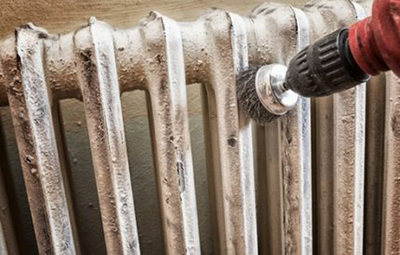
Radiator coating is produced after the end of the heating season. The paint simply won't stick to the hot surface.
This is also important in cases where it is required dismantle for example, for transporting them to a paint shop (for powder coating).
Necessary remove peeling old coating using an angle grinder, a drill with attachments, or a regular wire brush.
When processing old cast iron accordion radiators difficulties may arise. Completely removing the coating mechanically is possible only after complete disassembly of the radiator; this cannot be done without special tools.
The use of special washes, which are sold in the form of a gel or spray, will save you. After applying to the surface, you need to wait for some time, then remove the dissolved gruel.
If the radiator is old and there is dirt on the surface rust, a rust converter is used. It will bind the oxide molecules, resulting in a gray film on the surface, onto which a primer or paint is applied.
After preparing the surfaces, you need to "mat" them with medium and fine grit sandpaper For better adhesion to the primer or paint, thoroughly degrease with solvent, acetone.
Application of enamel
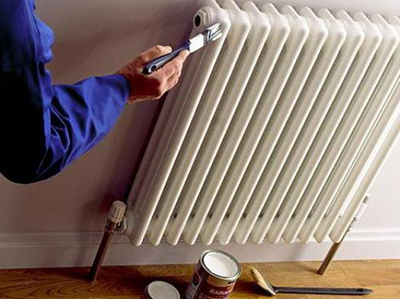
To apply primer and paint, choose soft or medium-hard brushes. For more curved radiator surfaces, use softer brushes.
If the battery is flat, a small one is used paint roller.
The composition is applied from top to bottom, starting from hard-to-reach places, carefully spreading the paint over the surface.
Application aerosol compositions will require a certain amount of skill: maintaining a distance when applying and the speed of movement of the stream (painters use the term “torch”).
After application the first layer of primer or enamel you will have to wait for it to dry, the time it takes for the layers to harden before re-applying (from an hour to several hours) - indicated on the can.
Important! During work, it is recommended to ensure good ventilation to avoid poisoning. If paints and varnishes with organic solvents are used, it is necessary work in a respirator.
As a rule, application is sufficient one coat of primer and two to three coats of paint.
Useful video
The video tells about what tools are needed for painting a radiator, how to decide on the choice of paint.
Results
With the current saturation of construction stores with various products, it is difficult to decide on the preference of the necessary product.
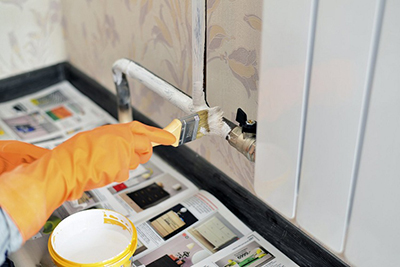
The choice of paints or enamels for the radiator is made based on specific conditions: battery status, aesthetic preferences and the degree of heating of the devices being painted.
Paint suitable for normal water systems, may not withstand high temperatures steam heating.
Owners of residential premises often complain about unpleasant smell after painting. The best way to avoid this is to read reviews from other people who have already tried the product.






